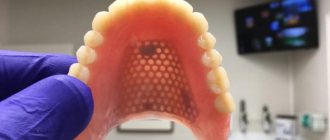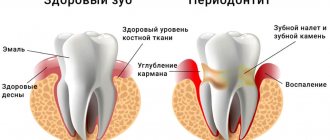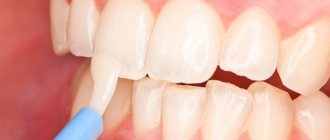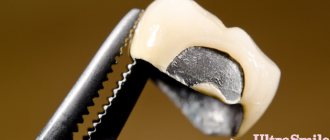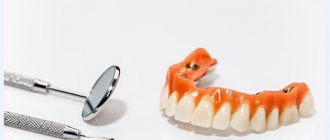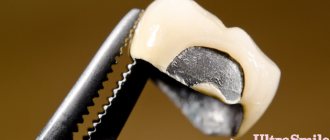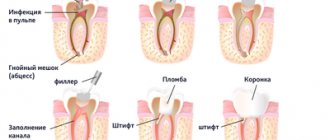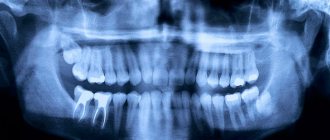Indications
The cavity located inside the tooth, where the nerve endings and blood vessels are located, is called the pulp. If the caries lesion is not treated in a timely manner, the pathology reaches the pulp, which leads to the occurrence of an inflammatory process called pulpitis. The process does not go away on its own; the pain that inevitably arises is removed by painkillers in the initial stages. Over time, they also stop working. In advanced cases, inflammation spreads to the bone, which leads to periodontitis and, as a consequence, osteomyelitis. The main indication for root canal filling is pulpitis caused by caries.
Is a refilling necessary if nothing bothers me?
Many patients are surprised when a dentist recommends replacing an old filling with a new one, because they have no pain or other unpleasant symptoms. However, replacement is carried out not only in cases of severe inflammation, but also for preventive purposes, as well as to improve the aesthetics of the dentition.
Like any other material, the filling mass is subject to gradual wear, deformation, and destruction. Hygienic care, oral microorganisms, saliva pH, mechanical, chemical and temperature effects of food over time provoke the appearance of microscopic cracks in the filling. The resulting pores serve as a breeding ground for microbes and the development of dental diseases.
Filling methods
Until recently, the procedure was carried out using pastes, which are inexpensive and do not require complex technologies. Now professional dentists have abandoned them due to insufficient fluidity, which leads to the formation of cavities. Voids lead to depressurization and relapse of inflammation.
At the moment, doctors choose progressive methods:
- Thermophile system. The filling is performed with hot gutta-percha, which hardens as it cools. It is characterized by high plasticity. There is no pain after treatment. The risk of complications is minimal;
- depophoresis. It is used for filling difficult, curved canals, as well as for restoring elements from which it is difficult to remove old fillings and where fragments of ostomy instruments remain in the cavities. Efficiency - no less than 95%;
- E&Q Plus. The latest generation method, which provides various methods of filling the roots of one tooth. The injection gun heats the gutta-percha directly inside the cavity. The doctor can control the temperature of the material using the information display.
Another common method is filling the canals with cold gutta-percha, which is used in several ways:
- lateral condensation;
- softening due to chemical action;
- with one pin. To give the shape, a pin is installed in the canal. Sealing is ensured through the use of paste.
There are other technologies that are selected depending on the location of the channels, the condition of the tissues and the experience of the doctor.
Stages of canal filling
First of all, the doctor carries out an examination and the necessary diagnostic operations, which may include, for example, an X-ray examination of the oral cavity.
If suspicions about the need to fill the canal are confirmed, the dentist carries out preparatory manipulations. First of all, adequate anesthesia. After it has taken effect, the caries-affected tissue is removed using a burr. The dental nerve is then removed. Next, the doctor is engaged in mechanical processing of the endodont - a complex of dental tissues, including pulp and dentin.
Upon completion of the preparatory stage, the empty root canal is filled, then a permanent filling or crown is installed.
How is dental filling performed?
Installing a filling is a standard procedure that takes place under local anesthesia. First, the person is given an injection in the gum to numb the problem area. After this, doctors proceed to treat the incisor, and the process lasts on average 15-20 minutes.
Main stages:
- The doctor prepares the enamel and drills out the softened dentin using a drill. The patient does not feel pain because he was given an injection.
- The oral cavity is disinfected using an antiseptic solution.
- A special paste with a healing effect is installed, and a gasket is placed for insulation.
- The walls of the oral cavity are dried using air flow.
- The mass is applied layer by layer for further filling.
- The filling is polished to obtain the required occlusion. The crowns should fit tightly.
- Fluoride varnish is applied for protection and distributed over the surface of the filling.
The procedure is simple and standard, so dentists perform it quickly. The patient only needs to listen to the doctor’s advice to avoid problems. If the filling is installed efficiently, it will last for more than one year. The specific period depends on the selected material, quality, and food preferences of the person. Filling is one of the most effective methods of combating caries and pulpitis. Moreover, the procedure is inexpensive and has a minimum number of contraindications.
Description of the procedure
- Local snapshot. X-ray allows you to see the condition of all channels, their number, location. In difficult cases, a 3D image is taken.
- Anesthesia.
- Drilling of diseased tooth tissues.
- Removal of nerve and blood vessels.
- Determining the depth of the canal using an apexolator.
- Widening the passage to place the drug and install the pin (if required).
- Filling.
- Control photo.
After treatment, it is not recommended to consume hot drinks and food for 1 – 2 hours.
Why does caries occur on young permanent teeth?
A teenager's permanent teeth have their own characteristics, and caries on them develops differently than on the teeth of an adult. That is why pediatric dentists treat caries in adolescents.
The fact is that a newly erupted tooth is vulnerable, since its mineralization remains low during the first year. Moreover, on molars and premolars, mineralization is finally completed only by 4-5 years after eruption. This is why the enamel on young permanent teeth of a teenager is still highly permeable, and the dentinal tubules are even wider than on baby teeth. As a result, the risk of caries is very high in the first year after eruption, and the rate of its development can be very fast.
Temporary filling
In some cases, medicine is introduced into the canals for a certain period of time. Manipulation is carried out for:
- elimination of pathological microflora;
- stopping the inflammatory process;
- isolation of the canal, when it is impossible to carry out treatment in one visit.
Indications for temporary installation of a filling are injuries, perforation of walls, periodontitis in acute or chronic form.
The main active components of medicinal non-hardening pastes are antibiotics.
Cost of services
Consultation with an implant surgeon 0 rub.
1-canal tooth (canal filling with gutta-percha pins) 750 rub.
2-canal tooth (canal filling with gutta-percha pins) 980 rub.
3-canal tooth (canal filling with gutta-percha pins) RUB 1,300.
Placing a temporary filling costs 200 rubles.
Compomer filling for permanent teeth RUB 1,000.
Filling for permanent teeth made of gypsum resin, cotton RUB 1,200.
Filling for permanent teeth made of photocomposite RUB 1,800.
Placement of a light-curing filling for non-carious lesions RUB 2,000.
Placement of a light-curing filling for average caries RUB 2,500.
Placement of a light-curing filling for deep caries RUB 3,000.
Placement of a light polymerization filling for periodontitis (taking into account the formation of a cavity and the application of a lining) RUB 2,350.
Placement of a light polymerization filling for pulpitis (taking into account the formation of a cavity and the application of a gasket) RUB 2,370.
Restoration of the crown part of a tooth using light polymerization materials (caries) RUB 3,050.
Restoration (caries, pulpitis) RUB 4,650.
Features of treatment of caries with hypoplasia
Filling carious cavities in teeth that have recently erupted is performed with materials with a caries-preventive effect. This is called a semi-permanent restoration. For the final restoration, composite materials and self-etching adhesive systems are used.
For the treatment of fissure caries in molars with hypoplasia, a preventive filling technique is relevant. The adjacent intact fissures are sealed after filling the carious cavity on the chewing surface of the tooth.
Possible complications after canal filling
In the absence of complications, the process can take about one to one and a half hours. But in severe and advanced cases, it may require several visits to the dentist.
The most common type of complications after filling a tooth canal is the neglect of the inflammatory process, accompanied by focal tissue destruction. In this situation, a temporary filling is installed from a non-hardening paste containing medications. The time of wearing it and the composition of medications is determined by the doctor during an individual consultation. This treatment shows high effectiveness for diagnoses of cystogranuloma and periodontitis.
Materials for canal filling
Unfortunately, situations are common in which pain continues to torment the patient even after all medical procedures have been completed, and after the period adequate for rehabilitation has expired. The reason for this reaction of the body may be an error in choosing the filling material. There is still no universal substance that would suit everyone. Consequently, dentists, based on their knowledge and the results of examining patients, each time make a choice in favor of one material or another.
Today the following substances are used for canal filling:
- fillers. They are represented by gutta-percha, silver and titanium pins;
- sealers. These are different types of cements, including polymer, natural, glass ionomer or containing calcium hydroxide, as well as polydimethylsiloxanes.
Gutta-percha can be called perhaps the most popular material due to the complex of its properties:
- leaves the tooth color unchanged;
- copes with absolute sealing;
- not subject to dissolution;
- not subject to deformation.
Can a crown save teeth?
First, the tooth and periodontal tissue are treated, and only then prosthetics are performed. How long does it take to get a crown on a tooth? Metal-ceramics are made in a dental laboratory; installation will take from 7 days, and metal-free Cerec options will be ready in 1.5 hours. When replacing a tooth with a crown, a protective case is put on it, protecting the fragile remains, deprived of nutrition after removal of the neurovascular bundle, from further destruction and preventing secondary caries.
If one or two dental units are missing, a structure is created: a crown on the abutment tooth and a bridge.
This method allows you to preserve the volume of bone tissue and eliminate inconvenience in everyday life. In this case, crowns will save not only units, but also periodontal tissue.
How long does a tooth live under a crown? With high-quality work and installation in compliance with the nuances of technology, metal ceramics can last more than 10 years, ceramic options 15 years or longer, and zirconium - 20 years.
Tooth canal treatment methods
Along with canal filling, other techniques are common in modern dentistry that allow you to preserve both the appearance and functional load of teeth.
These include:
- depophoresis method - designed to increase the efficiency of cleaning the canal from pulp tissue. It is based on the effect of copper-calcium hydroxide and a weak electric field on tissue.
- The method of obturation with the Thermofil system allows you to introduce thermoplasticized gutta-percha into the prepared root canal with high precision.
- Treatment with cold or heated gutta-percha allows you to achieve perfectly accurate filling of all tooth cavities after treatment.
It is important that the dentist strictly follows all ISO standards when selecting the instruments required for endodontic treatment. The caliber, diameter and even color of the instrument play an important role.
Medical errors in endodontic treatment
According to some data, Russian specialists achieve success with endodontic treatment in only 30% of cases.
The most common mistakes include:
- incomplete obturation (when filling the prepared dental cavity with filling material, air bubbles remain; the material does not adhere tightly to the tooth tissue);
- insufficiency, low quality of antiseptic treatment (threatens the occurrence of an inflammatory process);
- deformation, breakage of the pin or tool.
Can an ordinary patient who does not have a medical education determine the degree of qualification of the endodontist he sees? Yes. The first, main sign of a low qualification of a doctor or insufficient technical equipment of the clinic is the lack of an X-ray examination at the beginning of therapy.
If inflammation occurs or if pain lasts for an inadequate duration after filling a tooth canal, you should immediately consult a doctor. Delay may result in tooth loss.
Expert of the article you are reading:
Lozinskaya Alla Nikolaevna
Pediatric dentist, general dentist.
You may also be interested in:
Treatment of dental canals Treatment of teeth during pregnancy Dental consultation Treatment of dental cysts Increased sensitivity of teeth: causes and methods of treatment Treatment of pulpitis Treatment of fistula on the gums Treatment of flux (periostitis)
Show more
Is it possible to restore a tooth again?
Today, there are frequent calls from patients whose teeth are destroyed, treated 7-10 or more years ago. Back then, old technologies were used, the materials had expired, and the tooth needed to be restored again.
Many people just want to grind down the tooth and put a crown on it. During the consultation, we consider all methods. If the tooth has been filled and there is a chip in the filling or wall, then by eliminating the defect, this is possible. But, when complex restoration has already been carried out, especially on the frontal units, canines, replacement of old structures is necessary.
If the tooth was strengthened with a metal pin, and the wall was built up with a composite material, which darkened over time and began to crack, then drastic intervention will be required. First, you need to free the tooth from used materials: remove the filling, remove the pin. If necessary, treat incipient caries (often the patient himself does not know about the developing process).
The best way out
– this is the installation of inlays or solid modules, crown plus tooth root, using Cerec.
The scanner will “notice” all the structural features of the tooth; the program takes into account not only the features of the unit, but also all the nuances of the bite. How long does it take to make such crowns or complete modules for teeth? Only 1.5 hours
, small temporary deviations are possible.
The new tooth will look natural. During the consultation, we will decide how to restore the unit, what kind of crown is needed for the tooth, and choose the technology. At my appointment, you will feel calm, absolutely not afraid. Believe me, I will find a way to save a tooth even in the most difficult cases.
